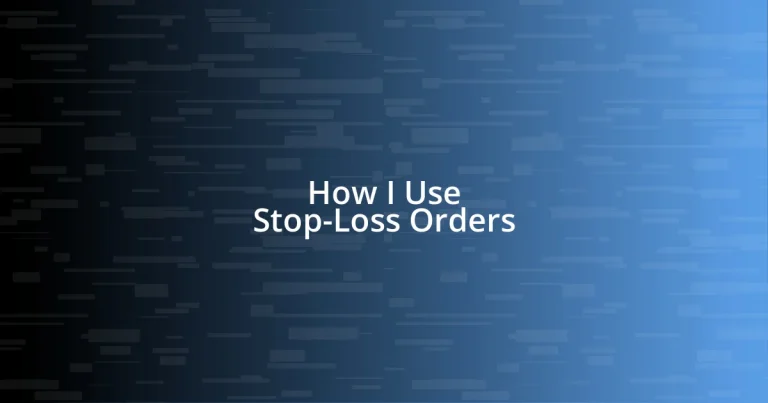Key takeaways:
- Stop-loss orders provide emotional control and risk management, allowing traders to stick to their strategies without succumbing to panic during market fluctuations.
- Different types of stop-loss orders (standard, trailing, stop-limit) serve unique purposes, enhancing adaptability and control within one’s trading strategy.
- Regular monitoring and adjustment of stop-loss levels based on market conditions are crucial for capital preservation and maximizing potential gains.
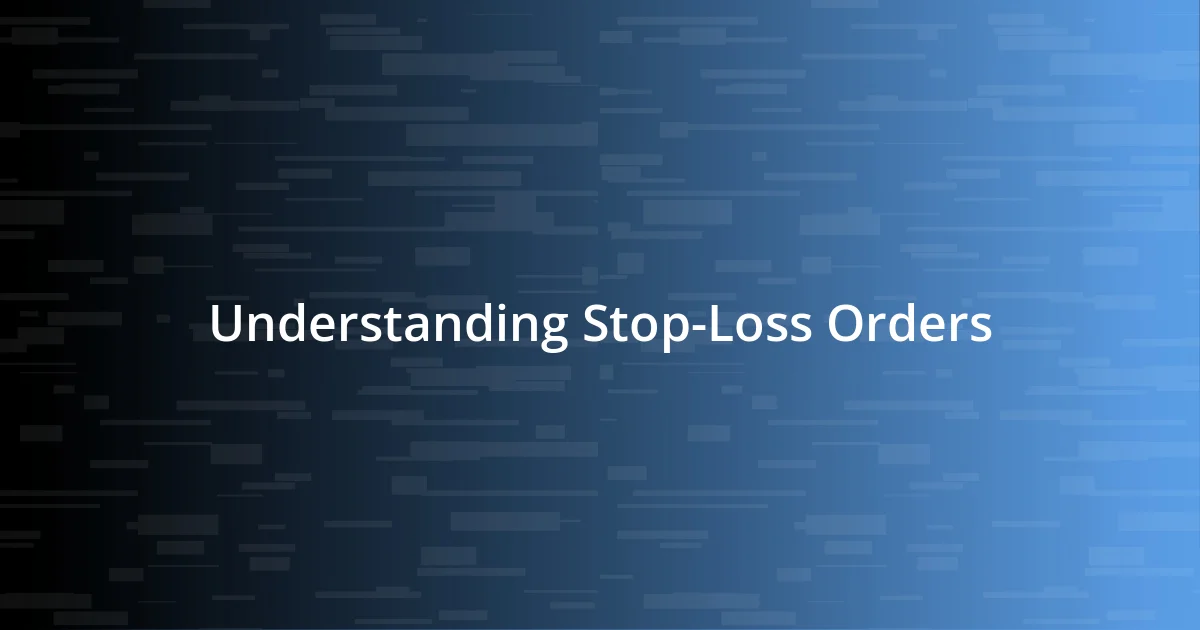
Understanding Stop-Loss Orders
Stop-loss orders are like a safety net in the unpredictable world of trading. I remember my first experience with them; I was nervous about a stock I had invested in, and I placed a stop-loss to protect my investment. That moment taught me the importance of setting boundaries to manage risk effectively – it’s like giving yourself permission to step away when things go south.
Utilizing a stop-loss can dramatically impact your emotional well-being as a trader. Have you ever watched a stock plummet in real-time, feeling that sinking pit in your stomach? By setting a stop-loss, I found that I could distance myself from that fear. It gives you a sense of control, helping you make decisions based on your strategy rather than being driven by panic.
Ultimately, stop-loss orders serve as a buffer against impulsive reactions. I often think about how they allow me to stick to my trading plan. Without them, I’d have likely made hasty decisions influenced by market fluctuations and my emotions. So, isn’t it comforting to know that there’s an approach to safeguard your portfolio while still allowing you to take calculated risks?
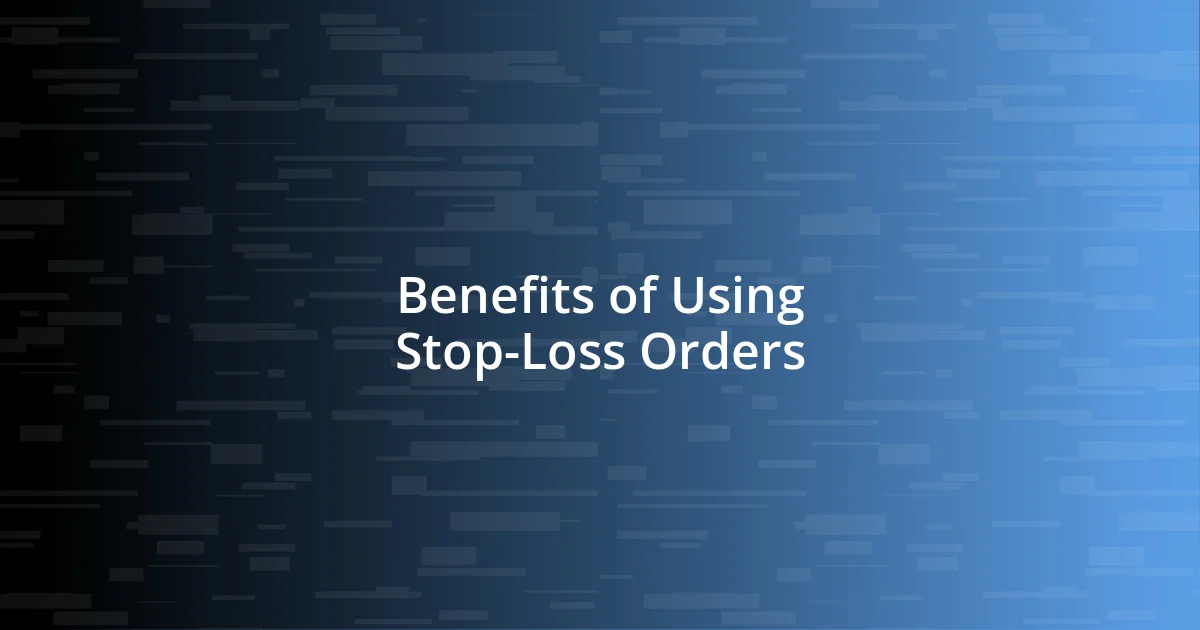
Benefits of Using Stop-Loss Orders
Setting stop-loss orders brings a sense of security and discipline to my trading routine. There were times when I would fixate on every dip and rise of my stocks, convinced that maybe this time, I should just hang on a little longer. When I started implementing stop-loss orders, it felt like I had a reliable partner in my trading decisions, one that said, “It’s okay to step back.” This approach not only protects my investments but also frees up my mental space, allowing me to focus on strategies rather than emotional turmoil.
Here are some advantages I’ve experienced from using stop-loss orders:
- Risk Management: They help set clear limits on potential losses, allowing me to align with my risk tolerance.
- Emotional Control: Knowing that I have a safeguard in place prevents me from making knee-jerk reactions when markets fluctuate unexpectedly.
- Time Efficiency: They enable me to execute my trading strategy without constant monitoring—much appreciated during busy days!
- Discipline Fostered: Stop-loss orders enforce a plan, helping me resist the urge to deviate based on short-term market noise.
- Capital Preservation: By minimizing losses, I can protect my capital and seek better opportunities without feeling financially strained.
These benefits have transformed my trading experience, making it not only safer but also more enjoyable.
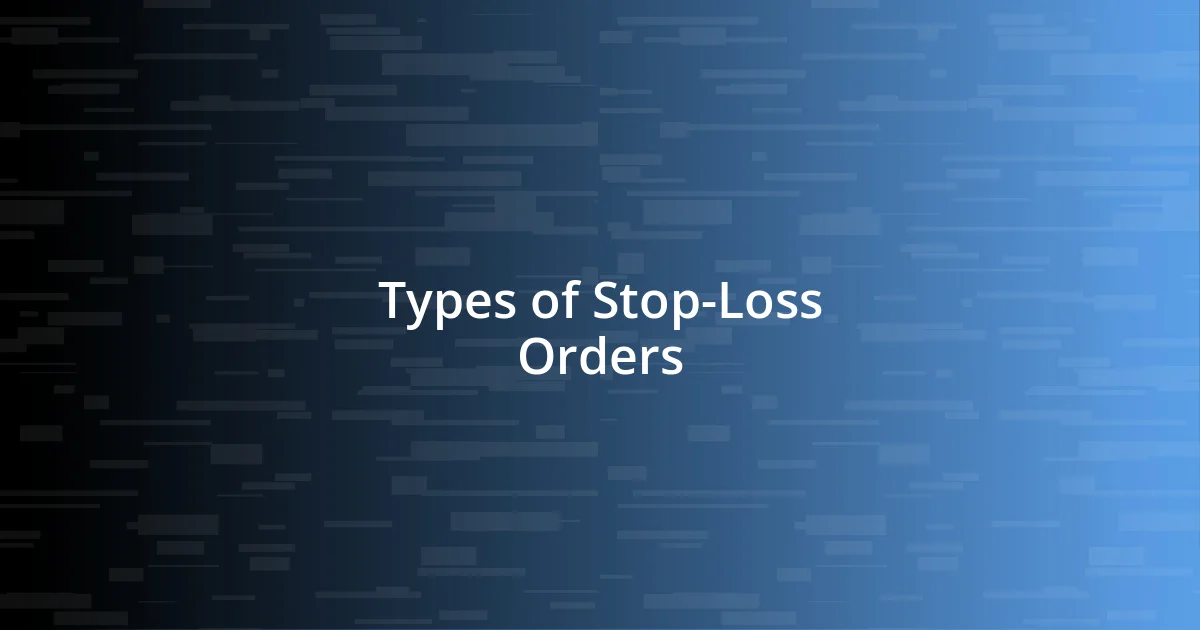
Types of Stop-Loss Orders
There are several types of stop-loss orders that can fit different trading strategies. The most common is the standard stop-loss order, which triggers when the stock price hits a predetermined level. I remember the first time I set one; it felt like I was finally taking control of my trade instead of feeling tossed by the market waves. On the other hand, a trailing stop-loss order adjusts automatically with the price movement, allowing for potential gains while still providing protection. I find this particularly helpful on volatile days when I want to protect profits without having to constantly adjust my positions.
Another type worth mentioning is the stop-limit order, which allows me to set a specific price at which I am willing to sell. This means I have more control over my exit point compared to a standard stop-loss order, which could trigger at a lower price during a rapid decline. There was a time when I used a stop-limit order successfully to sell a stock that was plummeting but still captured a decent exit point before it fell further. The flexibility these different types offer keeps my trading dynamic and responsive to the market.
In my experience, each type of stop-loss order has its role, and understanding them helps me align my risk management strategy. It’s like having a toolkit; some tools are better for certain tasks while others shine in different situations. I’ve learned that experimenting with these options has made me a more adaptable trader—a necessity in today’s fast-paced market.
| Type of Stop-Loss | Description |
|---|---|
| Standard Stop-Loss | Triggers a sale at a specific price point to limit losses. |
| Trailing Stop-Loss | Automatically adjusts with the stock price, locking in profits while protecting against losses. |
| Stop-Limit Order | Sets a limit on the sale price, allowing for more control during market downturns. |
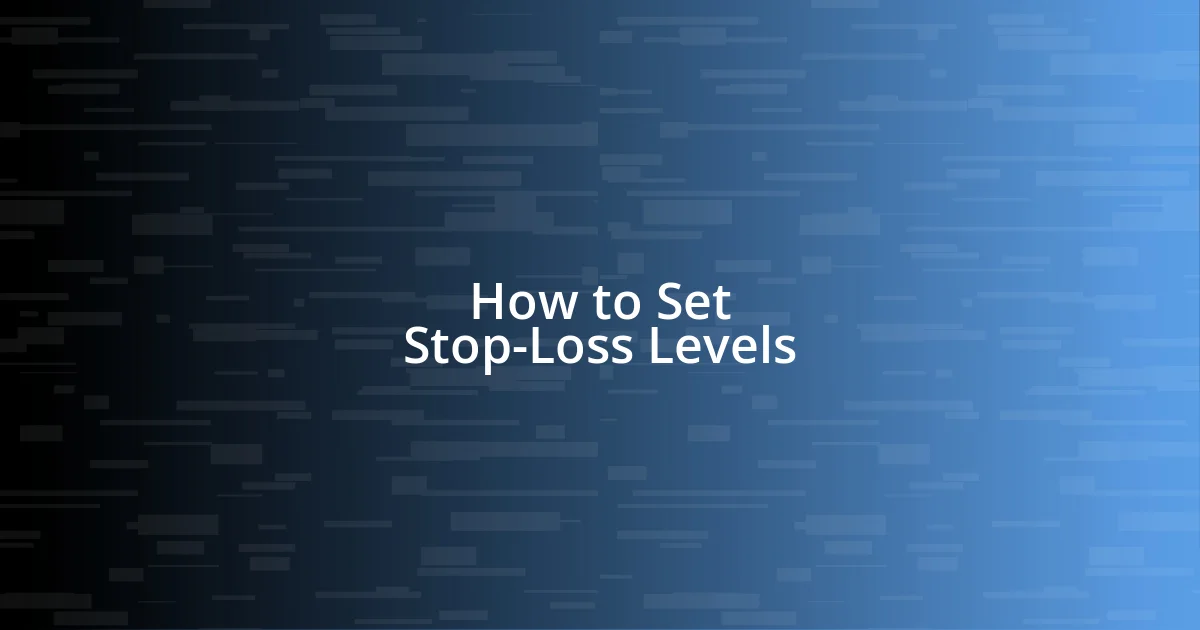
How to Set Stop-Loss Levels
To set effective stop-loss levels, I carefully consider my entry price and overall trading strategy. I typically set my stop-loss order a certain percentage below my buy price—this can vary based on the stock’s volatility. For instance, if I’m trading a stock that’s known for wild swings, I might opt for a wider stop-loss to allow for some price fluctuation without triggering an unnecessary sell-off. This reflects my understanding that no stock moves in a straight line, and I want my plan to accommodate that reality.
I often find myself looking back at my past trades to help determine the right stop-loss level, especially when I’ve faced losses. In one instance, I set my stop-loss too tight on a promising tech stock, and it hit my exit point shortly after I bought in, only to rebound significantly. That experience taught me the importance of analyzing historical price movements and setting my stop-loss levels accordingly. Wouldn’t it be frustrating to miss out on potential gains because I was overly cautious?
Another approach I take is mindful of overall market conditions. During periods of heightened volatility or when I notice significant support or resistance levels on a price chart, I adjust my stop-loss accordingly. I remember revisiting a stock that had been in a strong uptrend but started to show some weakness. Instead of sticking with my original stop-loss, I modified it slightly to just below a key support level, which not only gave me peace of mind but also aligned with my ongoing analysis of the stock’s performance. Adjusting my stop-loss in this way has often helped me hold on for longer-term gains instead of worrying about short-term fluctuations.

Common Mistakes to Avoid
When using stop-loss orders, one common mistake I’ve made—and seen many others make—is setting the stop-loss too tightly. I remember a time early in my trading journey when I was eager to protect my investments, so I placed my stop-loss just a hair below my entry price. A small dip caused by market fluctuations triggered my sell order, resulting in an unplanned exit from a stock that later surged. Isn’t it disheartening to realize that a tiny miscalculation can lead to missing out on significant gains?
Another oversight I’ve encountered is ignoring market conditions. Once, I was caught in a wave of optimism, convinced a stock was invincible just because it had risen sharply in recent weeks. I neglected to adjust my stop-loss as volatility crept in, ultimately suffering a larger loss than necessary. It got me thinking—how often do we let our emotions cloud our judgment? Understanding market trends and adjusting stop-loss levels accordingly is crucial for effective risk management.
Finally, failing to review and adjust stop-loss orders can be a significant blunder. In my experience, what works one day may not be appropriate the next, especially if the market sentiment shifts. There was an episode when I kept a stop-loss in place while the market dynamics changed drastically, and I ended up getting sold out of a position that later rebounded. It taught me the importance of continual evaluation—how proactive are we in revisiting our strategies as the market evolves? Staying vigilant can ultimately safeguard our investments and enhance our trading experience.
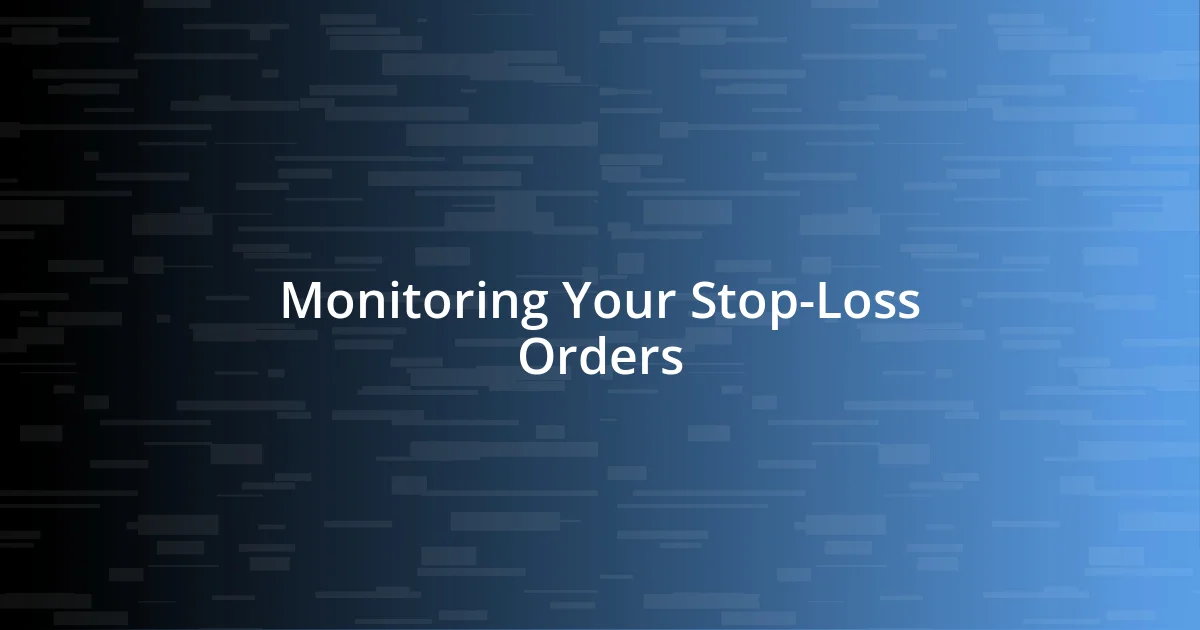
Monitoring Your Stop-Loss Orders
Monitoring my stop-loss orders is a crucial part of my trading strategy. I regularly check my positions, especially during volatile market periods. There was one time when I was too preoccupied with other tasks and missed a significant market drop that triggered my stop-loss. It felt terrible to realize I could have acted sooner to adjust my plans.
I’ve learned that it’s not enough to set a stop-loss and forget about it. I often find myself re-evaluating my levels as news breaks or market conditions change. For instance, after a major economic report, I quickly assessed my positions to ensure my stop-loss orders still reflected the latest risks. Have you ever experienced that rush of urgency that pushes you to reassess? In those moments, I remind myself that being proactive can make all the difference in preserving my capital.
Consistently monitoring my stop-loss orders allows me to stay in tune with both my investments and the market’s pulse. I’ve found that keeping a close eye on my trades has often led to better outcomes. Just the other day, I noticed a stock I was holding began to consolidate after a sharp rise. By adjusting my stop-loss to a more strategic level, I felt more secure, allowing me to ride the upward momentum rather than worry about a sudden downturn. Isn’t it empowering to take control of your trading decisions in real-time?
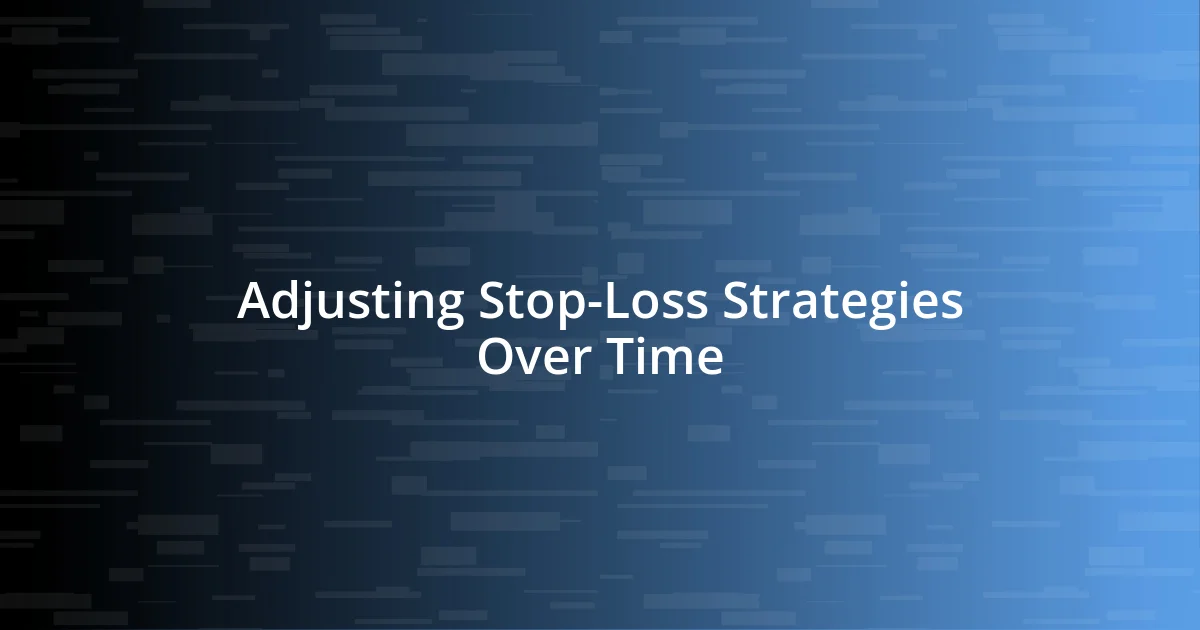
Adjusting Stop-Loss Strategies Over Time
Adjusting stop-loss strategies over time is essential for successful trading. I still recall a period when I was riding high on a couple of solid trades. I had my stop-loss set, but I neglected to revisit it as the market shifted. Suddenly, a news announcement caused turbulence, and my stop-loss executed, knocking me out of a position that rebounded spectacularly within days. I learned firsthand how important it is to reassess my strategies regularly. Have you experienced similar moments, where a lack of adjustment cost you potential gains?
As I gained more experience, I started treating my stop-loss levels like a living document. I actively revisit and adjust them to match market conditions, rather than treating them as set-and-forget orders. I remember when I realized that alongside price changes, factors like sector performance and economic indicators richly inform my stop-loss strategy. This shift in perspective not only improved my trading outcomes, but it also made me feel more connected to the markets. How do you keep tabs on the subtleties influencing your trades?
I’ve also discovered that using trailing stop-loss orders can be a game changer. I felt a wave of relief when I transitioned to this strategy; it allowed me to protect profits while still giving my trades room to breathe. One day, I opted for a trailing stop on a stock that had been climbing steadily. As the price rose, my stop-loss automatically adjusted, and I ended up benefiting from the uptrend while still securing my earnings. It’s such a satisfying feeling to find a strategy that allows for adaptability. What tools or tricks have you found effective in navigating the dynamic trading landscape?












